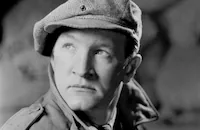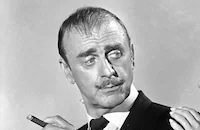Kazan
Cast & Crew
Will Jason
Stephen Dunne
Lois Maxwell
Joe Sawyer
Roman Bohnen
George Cleveland
Film Details
Technical Specs

Synopsis
In a frontier town in Northern Canada, at the turn of the century, government conservation officer Thomas Weyman learns from an old trapper that there is to be a staged fight between a dog and a wolf. When Weyman protests that the animal that Sandy Jepson is promoting as a wolf is really a dog named Kazan, the rowdy crowd shouts him down. Unable to stop the fight, Weyman and the trapper proceed to a nearby café, as do Louise Maitlin and her father, who runs the local trading post. The trapper admits to Weyman that he knows Kazan is a dog, but is afraid to get on the wrong side of Jepson. He then relates an earlier encounter with Kazan: On the trail, the trapper meets a man and his dog team and greatly admires the pure white lead dog, Kazan. Shortly after passing them, an avalanche buries the team's owner and most of the team. Only Kazan survives. At another table, Louise recalls her first meeting with Kazan: On the way to town with her ailing father, Louise and their guide McCready spot Kazan. Thinking that Kazan is a wolf, McCready takes a shot at him, but Louise stops him and befriends the dog. When she discovers that Kazan is wearing a collar, she decides, against her father's wishes, to keep him. During the night, Maitlin pays McCready to kill Kazan, but instead the guide chases the dog into the wilderness. The trapper now tells Weyman what happened to Kazan while he lived on his own in the wilderness: Lonely Kazan mates with a wolf, but she and her cubs are killed by a cougar. Kazan then kills the cougar. Weyman tells the trapper that he, too, encountered Kazan in the woods, while tracking with trapper Henri LeClerc: LeClerc is determined to catch the legendary white wolf that always kills the cougars he traps and destroys their pelts. When LeClerc succeeds in trapping Kazan, Weyman realizes that he is a dog and prevents LeClerc from destroying him. He then tries to win Kazan's affection, but despite his efforts, the dog becomes frightened, attacks Weyman and runs away. In the café, the trapper tells Weyman that Maitlin owns the Great Dane that is to fight Kazan. Weyman then tries to convince Maitlin to stop the fight, but he refuses. Jepson and the rest of the crowd then bustle into the café, and Jepson relates his encounter with Kazan: After Kazan wins a fight with a wolf, Jepson shoots him, planning to take his pelt. He changes his mind, however, and instead brings him to town. When Jepson finishes his story, the trapper draws him away from the crowd and reveals that he overheard him and Maitlin plan the fight and agree to bill Kazan as a wolf to increase the spectators' interest. As the crowd gathers for the fight, Kazan and the Great Dane are released into a pit, but they refuse to fight. Jepson then turns on Maitlin and Louise learns that her father was the fight's instigator. The disappointed spectators demand the return of their money. Trying to escape them, Jepson falls into the pit and is attacked by Kazan. Weyman leaps into the pit to save him, and after a furious struggle with Kazan, succeeds in taming the dog. The crowd cheers Weyman's success. Louise breaks with her father and then joins Weyman and Kazan, who seems to sense that he will soon have the right master and mistress.

Director

Will Jason
Cast
Stephen Dunne

Lois Maxwell

Joe Sawyer

Roman Bohnen
George Cleveland

John Dehner
Zoro

Ray Teal
Loren Gage

Harry Cording
William Norton Bailey
Brick Sullivan
Charles Jordan
Charles Sullivan
Stanley Blystone
Kernan Cripps
George Eldredge
Kermit Maynard
Allen Mathews
Dick Cogan
Crew

Film Details
Technical Specs

Quotes
Trivia
Notes
According to a January 1947 Hollywood Reporter news item, James Oliver Curwood's novel was purchased by producer Max King for production and release through Screen Guild. The Variety review states that the film was released in sepia tone, although the viewed print was in black-and-white.












